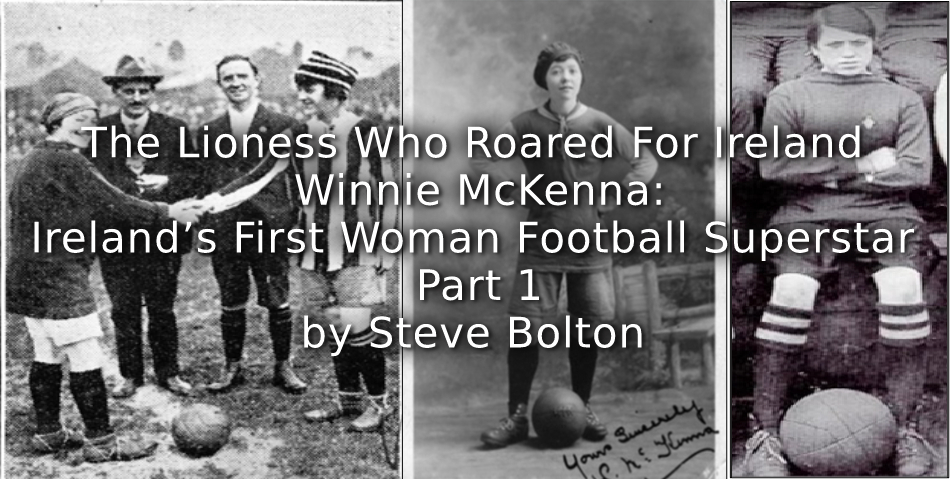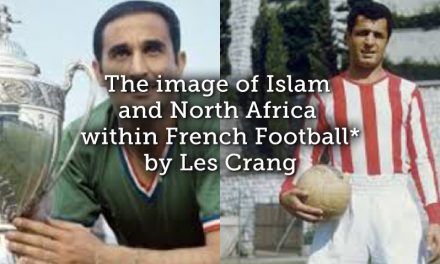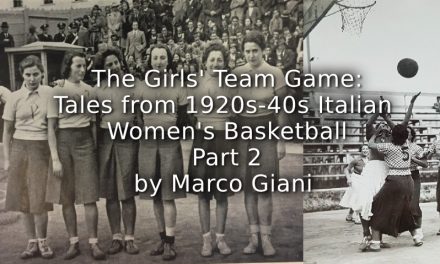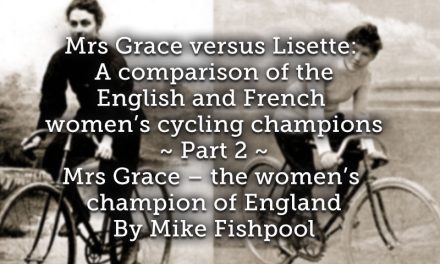Teesside and Irish Football Legend, Leader, Business Woman and Football Administrator
This is my tribute to one of the all-time greats of women’s football. Winnie McKenna had a career stretching from 1917 to 1936. She played at St James Park an incredible eleven times in front of crowds of up to 18-25,000 including the only two munitionette Cup Finals. She played at Ayresome Park four times in front of crowds of up to 18-22,000. She captained Bolckow Vaughan in the first munitionette Cup Final in 1918 and played for Brown’s Sawmills in the second munitionette Cup Final.

Winnie McKenna in action 1918, 1920 and 1936
Source: Courtesy BNA
Winnie played an astonishing 23 representative games in the northeast, often as captain during the two main World War 1 seasons. She represented and often captained Teesside, North of England, Durham, Tyneside, Newcastle and Sunderland. She was regarded as one of the best, if not the best player in the northeast, even compared to the famous Bella Reay. To quote the Newcastle Evening Chronicle in 1918:
“See McKenna at centre as good as any man”
“Mary Dorrian and Winnie McKenna had no equals”
Winnie is reputed to have scored over 200 goals in two seasons during World War 1 as centre forward and inside right. If, when World War 1 was over she had hung up her boots then she would have established a legacy as one of the greatest women footballers of her time. However, her career after World War 1 is even more amazing.
Winnie McKenna – A Footballer in Her Prime

Footballer, Leader, Administrator, Ambassador
Source: Wikicommons
Captain of Ireland at Windsor Park, Oval, Solitude and Bloomfield Road
Although born in Middlesbrough in 1897, Winnie had an Irish Catholic father from the County Derry/Tyrone area and saw herself as Irish. She was proud of her roots and spent a long part of her working life in Belfast. Part of her greatness was not just her on pitch skills but the fact that she was a natural leader. She was the obvious choice to lead a series of high profile ‘International’ games after World War 1 as captain of ‘Ireland’. The Ireland teams of this era were generally Northern Ireland selections, often exclusively from or associated with the Belfast region.
In 1921 the Sport newspaper of Dublin reported:
“Miss McKenna, a Lurgan young lady who plays football as cleverly and speedily as mere man, was half the Irish side and scored 2 goals.”
In Part 1, I will start to explore her career as Captain of Ireland up until the end of the 1920-1921 ‘Golden Season’.
In Part 2, I will explore her career as Captain of Ireland during and after the 1921-1922 ‘Ban Season’. This will also include her role as a successful, independent business woman and football administrator.
Parts 3, 4, etc will explore her career as a munitionette footballer.
Please note that thank yous and credits will appear from Part 2 onwards.
Winnie McKenna – Football Administrator and Charity Fundraiser

Winnie McKenna with Lord Mayor of Belfast City at Hall
And the Legendary Carmen Chantelle Marianne Pomies
Source: BNA Northern Whig Tues 11 August 1936 p12
International Football Match Organiser
This was the last great international football match in Northern Ireland of the interwar period. The renewal of sectarian troubles in 1933 largely brought the amazing 1930s growth of high profile women’s football to an end. An exception was this revisiting of the great Ireland v France (read Molly Seaton vs Carmen Pomies) battles from 1932.
Winnie was born in the most humble of circumstances in 1897 in Grangetown, Middlesbrough. Here she is in 1936, a single woman, organising a high profile football match and charity fundraiser. She is celebrated in the Belfast newspapers being honoured by the Lord Mayor of Belfast and other dignitaries.
The Global Lily Parr Nonsense Industry

Photo Taken of Football Legends and Friends in 1933 in Whittingham
Source: LizzyAshcroftCollection
Myth vs Legend vs Evidence
The most famous women’s football team is the Dick Kerr Ladies of Preston. The most famous player for the Dick Kerr Ladies was Lily Parr and she is often used as a metaphor for the all the women footballers of that era in the popular media. This is a problem and unfortunately what is written about Lily by a lot of modern writers is nonsense. The main nonsensical claims are that she was 6 foot tall, a professional footballer, a rugby player and that she was openly gay.
My granny, Lizzy Ashcroft was a great friend of Lily and played with her for nearly 13 years and so I can speak with some authority about Lily. She was not 6 foot tall, she was 5 foot 8 inches tall (same as my granny). She was not professional, she was an amateur footballer who worked at the Dick, Kerr and Co factory and then in 1926 worked at the Whittingham County Mental Hospital with my granny in rural Goosnargh. She did not play rugby, she played a fine game of cricket and hockey. She shared a house with a woman and this is the only ‘evidence’ that she was openly gay. I shared a house with an older West Indian cricket friend when I was a young man. I can assure you that our only mutual passion was for cricket and curried goat. The modern ‘openly gay’ epithet is understandable but unhelpful.
The Dick Kerr Ladies are the legendary women’s football team of history. This is unarguable. However, sometimes more is attributed to them than is accurate and other teams are ignored. It is with wry amusement that I read that they were the pioneers of women’s football. I would argue that modern women’s football as we would recognise it today came to the fore towards the end of World War 1. The Dick Kerr Ladies were latecomers to this thriving football scene. The real pioneers of the munitionettes football scene were the women of the industrial northeast. The Dick Kerr Ladies formed for their first game on Christmas Day in 1917 in front of a crowd of 10,000 taking £338 and 7 shillings at the gate for charity. On the very next day in 1917, an International women’s football match was taking place in Belfast between representative teams of north eastern munitionettes and Belfast region munitionettes. The north eastern munitionettes had held a Possibles versus Probables game 11 days earlier from 10 different local sides to select the tour party. What is even more incredible was that this was the 115th game in the region (which eventually had around 270 documented matches during World War 1). To give just one example. During the very early 1916-1917 season the Expanded Metal Company of Hartlepool had played three games by 12th May 1917 to a combined crowd total of 10,000, a full 7 months before the Dick Kerr Ladies played their first ever game. Significant early World War 1 games also took place in other parts of the country.
1919 Winnie McKenna Superstar – “Over 130 Goals This Season”

“See Bella Reay and Winnie McKenna, who have scored 230 goals”
Source: BNA LEP Thurs 6 March 1919 p1
The Lancashire Evening Post further commented in a taster for the first game of the last epic two World War 1 Tussles between Lancashire (Dick Kerr Ladies & Bolton) and the northeast (0 – 1 and 0 – 0):
“Included in the Newcastle team is Miss W McKenna, who has scored over 130 goals this season”
The Dick Kerr Ladies were a truly great football team and I would make the point that to be a truly great football team you need to have had truly great opposition.
They did.
1920 Blackpool – Ireland 0 v 7 England
Played at Bloomfield Road on Wednesday 29 September 1920

Ireland Captain Winnie Mckenna with DKL Captain Alice Kell
Mayor of Blackpool and Referee
Source: BNA Daily Mirror Friday 1 October 1920 p9
Ireland Captain Winnie McKenna Pictured in Daily Mirror and Leeds Mercury
This was the first post World War 1 International match billed as Ireland vs England. Newspaper reports claimed that the Irish team was from “Belfast, Dublin and other parts of Ireland”. By this point the Dick Kerr Ladies were the most famous and successful football team in the UK. They had made the fairly unique transition from munitionette’s football team to post war team and had accumulated the cream of talent from the north west football ‘scene’. Jenny Harris, regarded as the best player in the northwest had been brought in from the National Projectile Factory Lancaster and had formed an established and lethal scoring partnership up front with the great Florrie Redford. Also, uniquely the Dick Kerr Ladies had managed a half full 1919 – 1920 season playing 14 games including 4 against the visiting French side. In May of 1919 a raw, talented young full-back had been signed from St Helens and had only just made her debut: Lily Parr. The Dick Kerr Ladies also boasted the first imported International player. The national French goalkeeper Louise Ourry had remained in England after the May tour and was keeping goal for the Lancashire lasses. This was the 5th game of the new season for the all conquering Dick Kerr Ladies. They were not going to be defeated again until an astonishing March 1923 when my granny’s St Helens Ladies FC thrashed them by 5 goals to 1.
Irish Players In Green Tops, Dick Kerr Ladies in Black and White Stripes

Miss Fisher (Ireland) Intercepts a pass from Miss Redford at a critical moment
Author’s Note: DKL Florrie Redford in stripes is behind Miss Fisher who has the ball
Source: BNA Daily Mirror Friday 1 October 1920 p9
This game was played at Bloomfield Road (home of Blackpool FC) in front of a crowd of 6,000 spectators. The game had originally been offered to the Bath Ladies by DKL but they couldn’t make it so it is unsurprising that a largely ‘cobbled together’ Irish team lost by 7 goals to 0, of which the great Jenny Harris accounted for 5 playing at inside left. The Irish goalkeeper, Miss Turkington, was acclaimed the best Irish player and was credited with keeping the score to single figures. The game was a great success. The ball was sold for auction after the game and total proceeds amounted to £500. The Red Cross and Manchester and Liverpool Universities Appeal Funds were the beneficiaries.

Winnie McKenna on view in Newsreel in Belfast
Source: BNA Belfast Telegraph Friday 22 October 1920 p1
Later that month a film of the game was shown in the Imperial Theatre, Belfast, together with the popular film “Break the News to Mother”!
1921 Belfast – Ireland 2 v 3 England
Played at Windsor Park on Tuesday 29th March 1921

The Event of the Easter Holidays in Belfast
Source: BNA Northern Whig Monday 28 March 1921 p3
Winnie McKenna Captain’s Ireland in Front of 10,000 at Windsor Park
Diana Scott organised this largely northeast England vs Belfast clash. The game was played on Easter Tuesday and despite the inclement weather attracted a large crowd of 10,000 to Windsor Park. England played in white whilst Ireland played in their usual green shirts. The Hartlepool Northern Daily Mail announced the trip, noting that a number of well-known local footballers had been selected. The paper also noted that “Miss W McKenna, who played for Brown’s Girls, West Hartlepool, is to be centre forward and Captain of the Belfast team.” The game was organised by and as a testimonial to Diana Scott, the indefatigable organiser of fundraising, especially through women’s football matches. A close match was foreseen with the Northern Whig pointing to Bella Willis (a hefty defender), Sarah Cornforth (a wonderful centre half who never tires), Mary Dorrian and Minnie Seed (a clever pair on the right wing). Minnie is described as the fastest lady footballer in England and 17 year old Mary Lyons, the little inside-left, is described as “a box of tricks”.

Action shots at the England v Ireland ladies match, played at Windsor Park
(1) Miss Ruby Hall (marked x) scores the opening goal for Ireland
(2) An Irish attacker held up
Source: BNA Belfast Telegraph Thursday 31 March 1921 p4
This was an exceedingly close game with Ireland leading by 2 goals to 1 at half-time. Two of the English goals were scored by Mary Lyons and she was praised as the best player on the field by the Irish Newspapers. The Northern Whig described Mary as: “the most accomplished player on view” and the Sport Newspaper of Dublin said of Mary: “she was fast, and clever as say Kelly of Burnley.” This was after commenting that the “dear girls played football rather well”. It is interesting to note that in the team lists Winnie is named at fullback. Perhaps she was aware of the strength of the opposition forward line whom she had played with and against many times and had drafted herself in to shore up the defence?
1921 Middlesbrough – North East Coast 6 v 2 Fleetwood
Played at Ayresome Park on Wednesday 27th April 1921 – Crowd 10,000

Winnie McKenna
“A Fair Footballer”
Source: BNA North Star Wed 27 April 1921 p6
Captain Winnie McKenna and Mary Lyons Hat-tricks
Fleetwood were one of the stronger teams from the Lancashire football ‘scene’. This was their 16th game of the season and they had just lost the previous match by 4 goals to 0 to the famous Dick Kerr Ladies. They were put to the sword by the North East Coast Ladies. This was a robust football match with the North Star Newspaper in Darlington commenting:
“Good shoulder charges were given and taken with good grace, and in the true sporting fashion.”
“Miss Winnie McKenna put in some brilliant work, and, although playing at centre half, accomplished the hat trick.”
By now Winnie was nearly 24 years old and one of the most experienced footballers and captains in the country. It is no surprise that with her all-round skills she had moved to centre midfield.
1921 South Shields – Tyneside 6 v 0 Chorley
Played at Horsley Hill on Tuesday 10th May 1921

Jarrow Legend Mary Lyons Scoring with a Back Heel
Source: BNA Daily Mirror Friday 13 May 1921 p12
Mary Lyons Back Heel Goal 101 Years Before Alessio Russo
Chorley Ladies were another strong side from the Lancashire football scene. On 18 December 1920 they lost to the DKL by 7 goals to 0, but had then beaten Fleetwood 4 v 0 and 2 v 1. Recently though, they had lost two games in succession by a score of 2 v 0 (Fleetwood and Lancaster) and had lost two of their strongest players. The game was kicked off by Mr Edwin Winter, the manager of the Empire Theatre, South Shields and was to raise money for the Warriors Day Fund and the Mayor’s Fund. The Mayor and Mayoress were scheduled to attend the game, which was judged to be a financial success.
Mary Lyons Superstar

Mary Lyons
Source: Wikicommons
Author’s Note
Scant details have so far emerged about this game. Winnie McKenna is not on the published team list for this particular game.
Mary Lyons was from Jarrow and several years younger than Winnie McKenna. Like Winnie, Mary Dorrian, Sarah Cornforth, Minnie Seed, and others she has been up until now regarded as ‘one of a supporting cast’ of northeast football players. Research is ongoing in this area and she is reputed to have been of Irish heritage and to have had rather a sad life after football before passing away in a Jarrow care home in the 1970s, unheralded and unremarked. I am sure that Lionesses Beth Mead (Whitby) and Jordan Nobbs (Stockton) and indeed Alessia Russo would be as impressed as I am by the cheeky back heel picture featured in the Daily Mirror over 100 years ago. The Lionesses are continuing a proud heritage of women’s football.
1921 Middlesbrough – North East Coast 1 v 3 Dick Kerr Ladies
Played at Ayresome Park on Wednesday 11th May 1921 – Crowd 18,000

Dick Kerr Ladies pictured earlier in the Season in Black + White Stripes
Florrie Redford with Cup, Florrie Haslam seated behind her
Source: Lizzy Ashcroft Collection
Florrie Redford Scores 2 and Florrie Haslam Scores 1
The great Dick Kerr Ladies were unbeatable at this stage. North East Coast Ladies did well to hold them to a respectable 3 to 1 loss. The news media appeared to be starting to lose a little interest by this stage of the 1920 – 1921 Season. The Dick Kerr Ladies would only play four more matches in this the ‘Golden Season’ of women’s football before the English FA moved to throttle women’s football in the following 1921 – 1922 ‘Ban’ season with its nearly 50 year ban.
The crowd attracted was reported as 18,000 and the money was being raised for ‘alleviating distress amongst the unemployed’. It was with some irony that the Hartlepool Northern Daily Mail reported:
‘A considerable number of unemployed assembled outside the ground, and it was intimated that they would be admitted at the interval. They, however, became impatient and burst open one of the large exit gates, and swarmed into the ground.’
The same newspaper reported 10 days later under the headline: “150,023 Idle – Unemployed In The Northern Counties” that the number of unemployed was on the increase and further large factory closures were expected. It should be noted that there was tremendous shame attached to being unemployed, even if it wasn’t your fault. Families starved. I have written about similar conditions and fundraising by women footballers in Manchester in the same period under the title “The Football Game Which Makes Me Cry”. We should be very, very proud of these women.
1921 Belfast – Ireland 1 v 1 England
Played at the Oval on Saturday 21st May 1921 – Crowd 10,000+

Source: BNA Belfast Newsletter Saturday 21 May 1921 p2
Captain Winnie McKenna Reported as the Best Player
The Lancashire Ladies were actually Fleetwood Ladies and by this point had become one of the stronger teams in a burgeoning Lancashire Football scene led by the legendary St Helens and Dick Kerr Ladies. They were quite a spectacle with their red and white striped tops and blue shorts. One week before this game was played they were able to poach two of rival Chorley’s strongest players Polly Scott and T Berkins. Polly Scott went on to play for the Dick Kerr Ladies and Berkins for Rochdale Ladies.

Fleetwood Ladies FC
Source: Courtesy English National Football Museum
This was Fleetwood’s 20th game. It was their first ‘International’ and the thought of the trip must have been very exciting. The match was again organised by Diana Scott and the money was to be devoted to the Templemore Hospital for Women and Children. The Oval was the home of top male professional side Glentoran. Raising money for hospitals was a real feature of the success of women’s football in Northern Ireland and was the stimulus for the resurgence of football there in the 1930s.
Author’s Note
The Fleetwood Chronicle reported the Belfast Games involving Fleetwood as having Crowds of 17-20,000. I have stated a more cautious 10,000+ both games as I suspect that these figures were highly inflated once everybody arrived back in Fleetwood. Further evidence may arise.
1921 Belfast – Ireland 3 v 1 England
Played at Solitude on Saturday 4th June 1921 Crowd 10,000+

Captain Winnie Mckenna Scores 2
The game was the first win for Ireland. It was heavily advertised as a key fundraiser in Belfast for Earl Haig’s ‘Warrior Day’ Fund. It was also advertised as Ireland v Scotland and even reported as such. However, the Irish opponents were Fleetwood Ladies. The game was once again organised by Diana Scott.
“The stalwart of the home side was McKenna”
The quote above is from a detailed match report in the Fleetwood Chronicle. McKenna scored the first two goals for Ireland, the first with a “strong drive from a free kick” and the second from a “beautiful cross”. She really was playing a captain’s game as the paper also commented in the first half: “McKenna also distinguished herself by stopping the visitors.” The Irish newspapers were no less complimentary with the Sport newspaper of Dublin commenting:
“Miss McKenna, a Lurgan young lady who plays football as cleverly and speedily as mere man, was half the Irish side and scored 2 goals.”
£193 was raised for the Warrior Day funds. After the game both teams were entertained with a host of dignitaries at the Carleton Cafe in Belfast with speeches following an “excellent repast.” Winnie McKenna spoke briefly in her role as Captain and was not overawed. The following day the visitors were entertained to a tour of the Down Coast in a charabanc with lunch at Crawfordsburn, near Bangor.
Author’s Note
The Sport newspaper of Dublin reported that the crowd was 4,000 and the Fleetwood Chronicle newspaper reported that the crowd was 17,000.
Conclusion to Part 1

Go Away, We’re Busy
Source: BNA
I must confess that when I embarked on a detailed study of Winnie’s career I expected to be able to fit everything into one article. More and more material emerged. The vast majority of women’s football of this era was played in seasons, like the men’s game, and so that is how I analyse this history. There are, of course, exceptions. If you would like to read more about ‘the ban’ then there is another article on Playing Pasts which is entitled: “When Football Banned Women”. I co-authored this article with Professor Fiona Skillen to encourage some wider thinking around the circumstances of the 1921-1922 ‘ban season’ – to read this article click HERE
Part 2 continues with Winnie’s career and life in Belfast.
Article © of Steve Bolton, January 2023






Hi Steve
Loved this revisionist piece. Coming from the north-east as I do, it’s a great reminder of regional women’s football. There’s quite a bit of newsreel coverage of women playing soccer between the wars. I wonder if Winnie features there?
Mike Huggins
Hi Mike
Thanks – I enjoyed researching and writing. More to come!
Most of the 1914-1919 newsreel footage is very south east ‘centric’, showing Sterlings of Dagenham or Vickers Crayford/Dartford. An exception is what is labelled and thought to be the snow covered 1919 Munitionettes Final. (Ref: British Pathe England: Football/Soccer: Girls Football Cup Final 1919). I am 99% certain that the second player in the second team receiving her medal as the losers is Winnie McKenna.
Regards
Steve
Really good article.
I have been promoting the story of Women’s Football in the North East for some years with talks to various organisations, including a football academy.
Some years ago I organised a ‘replay’ of the 1918 Munitionettes Cup Final, with Blyth Spartans represented by a team from Gateshead College and Bolckow Vaughan represented by a team from Middlesbrough College. On that occasion the Teesside team gained revenge for the earlier defeat.
I have also worked with various groups to discover the stories of Winne McKenna, Florrie Short and Bella Reay. A friend, Ed Waugh, has written and produced a wonderful play ‘Wor Bella’ about Bella Reay.
Thank you for providing more detail on Winnie McKenna’s international career.
Martin
Martin
Really appreciate your comments. Thank you.
I am aware of the game you organised + the fab stuff around ‘wor bella’. Fabulous.
Swap notes when I get to visit the area?
Steve
Hi Steve, Winnie McKenna was my great aunt and although we knew that she had played football during the first world war we were not aware that she had such an illustrious career. On behalf of the family I would like to thank you for your wonderful, informative article.
Hi Steve, what an interesting piece. This lady is buried in our cemetery on the 15th March 1971 aged 73
There is a Elizabeth Noteyoung in the grave, buried on the 12th June 1974 aged 82 perhaps her older sister
Sorry there is no memorial Just wondering why she was buried in Redcar
We have been looking after the cemetery here for 19 years.
I am the secretary of a group of volunteers